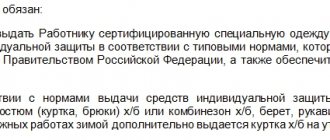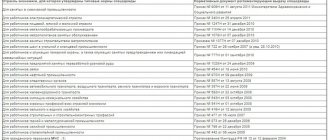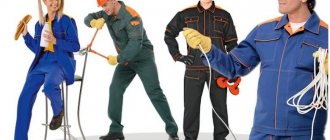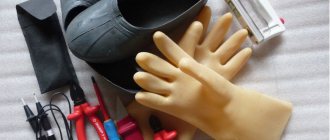Home / Labor Law / Occupational Safety and Health
Back
Published: 08/24/2016
Reading time: 10 min
0
9038
From the beginning of 2021, enterprises that pay to the Social Insurance Fund will be able to compensate for the costs of purchasing safety shoes, workwear and other personal protective equipment (PPE) through injury contributions.
Moreover, only the cost of workwear produced in Russia and from Russian materials is subject to reimbursement.
- Legislative acts Order of the Ministry of Labor of the Russian Federation No. 201n dated April 29, 2016
- Order of the Ministry of Health and Social Development No. 290n dated June 1, 2009
Who is entitled to special clothing?
The validity and procedure for issuing workwear is standardized by the documents posted below. You can clarify professional details, find out who is entitled to work safety clothing, what are the conditions for its issuance and use, and what responsibility the employer bears.
- Orders No. 297, 477 of the Ministry of Health and Social Development of the Russian Federation dated April 20, 2006 and July 16, 2007 (respectively);
- Order No. 997-N of the Russian Ministry of Labor dated December 9, 2014;
- Resolution of the Ministry of Labor of the Russian Federation No. 70 of December 31, 1997;
Providing workers with special clothing is also carried out on the basis of OSH standards (they form an idea of who is entitled to special clothing in the organization).
Deadlines for issuing workwear to workers by industry
The employer should use the rules for a specific industry, which are reflected in the decrees and orders of the ministries. For example, the timing of the issuance of special clothing to catering workers is regulated by Resolution of the Ministry of Labor No. 68:
- the manufacturer of semi-finished food products is given a rubberized apron with a bib and a pair of rubber galoshes;
- kitchen worker - two pairs of combined mittens;
- for a dishwasher and a worker for washing boilers - a rubberized apron with a bib.
All sets of workwear are provided for a year from the date of actual issue; dishwashers and boiler washers are also provided with rubber gloves. To understand for how long work clothes are issued for cleaners and cloakroom attendants, even if they work in public catering, you should study the rules for cross-cutting professions.
What special clothing is required for the driver?
The question of whether drivers are required to wear special clothing is answered by standards that stipulate that the driver’s special clothing should be comfortable and not distract from driving.
Varies depending on the specifics of the activity. Standard set includes:
- anti-pollution suit;
- cloak;
- signal vest;
- boots or boots made of leather with a protective toe cap (demi-season and winter);
- rubber boots with protective toe caps;
- suit with insulated lining;
- felt boots with rubber soles;
- several types of gloves, including insulated ones.
Legislative acts
Order of the Ministry of Labor of the Russian Federation No. 201n dated April 29, 2016
The order amends another order, No. 580n dated December 10, 2012, on financial support for measures to reduce injuries and occupational diseases. These documents, in addition to PPE, regulate the procedure for applying for funds for other similar purposes:
- providing those employed in harmful and dangerous working conditions with therapeutic and preventive nutrition (milk);
- providing vouchers for sanatorium-resort treatment for such employees;
- conducting medical examinations;
- purchase of first aid kits, and for transport enterprises - tachographs and breathalyzers;
- training and retraining of labor protection specialists;
- assessment of working conditions and certification of workplaces;
- other similar events.
PPE is reimbursed only if the issue complies with standard standards and is provided free of charge to employees.
The policyholder will need to prove:
- compliance of certified workplaces with working conditions and professions for which PPE is required;
- compliance of PPE with the technical regulations of the Customs Union “On the safety of PPE” No. 878 dated December 9, 2011;
- compliance of all personal protective equipment with issuance standards.
Standards for the provision of PPE, requirements for their acquisition, issuance, storage, and care are contained in Order of the Ministry of Health and Social Development of the Russian Federation No. 290n dated June 1, 2009.
Order of the Ministry of Health and Social Development No. 290n dated June 1, 2009
The order contains general inter-industry rules that apply to all employers, as well as the definition of PPE - strictly personal protective equipment that is intended to:
- for protection against contamination or temperature conditions;
- to reduce the degree of exposure of workers to harmful factors.
The employer is obliged to provide appropriate PPE free of charge, in accordance with the personal characteristics of the employee and as often as required by the rules.
It is permissible to draw up a lease agreement and issue personal protective equipment at an enterprise for temporary use. Products must be certified. The employee must be notified of the standard applicable to his position.
Priority in provision, according to the order, belongs to industry standards for the type of activity of the enterprise, and for workers in cross-cutting professions that exist in many enterprises - according to standards for types of work.
What kind of work clothes are required for office cleaners?
Very often, the workwear of representatives of this profession is confused with a uniform. Are office cleaners required to wear special clothing? Certainly! Cleaners are given:
- suits (jacket+pants);
- overalls;
- robes;
- aprons;
- special shoes.
What kind of workwear should you have?
Every worker and employee engaged in production has a legislative right to work clothes, footwear, and effective protective equipment.
Order of the Ministry of Labor dated 10/19/16. (No. 438n) focuses on the fact that when providing personnel with special clothing, the employer must proceed from specific working conditions.
Before buying workwear, it is important to consider that all equipment must have certificates of compliance with TR CU 019/2011 “On the safety of personal protective equipment.”
The employer has the right to establish individual standards, but only in the direction of improving the standard requirements approved in the legislative framework.
Extension of deadlines for issuing workwear
At the end of the wearing period, the employee must hand over the workwear to the employer. But there are times when things are still wearable. But in order to issue them again, you need to assemble a commission that will assess the percentage of wear and tear and decide whether to write off the workwear or issue it a second time. Before reissue, the used kit must be disinfected, cleaned and repaired. To ensure that workwear wears out more slowly, it is allowed to issue a double standard of sets. For example, a milling operator is entitled to two protective suits for a year and a half, but an employer can give him four suits for three years.
Overalls in labor protection - requirements and rules
- Meet the required protective characteristics.
- Create a good microclimate and convenience for the user, regardless of weather and working conditions.
- Possess high resistance to wear and mechanical damage.
- Made from quality material.
- Meet the requirements of SanPiN for workwear.
- Be aesthetic.
- Match the physical characteristics of workers.
For some professions, clothing with all sorts of additions is suitable - pockets, hoods, etc. And for others, streamlined shapes are necessary to prevent protruding parts of the suit from getting into rotating mechanisms
We accept PPE
When PPE arrives at the enterprise, it is necessary to verify its proper quality, the required quantity, the nomenclature specified in the supply agreement (supply application), and also check for standard sizes, heights and accessories (male, female).
All accepted PPE must have a certificate (declaration) of conformity and established markings; The quality of PPE must meet the stated requirements.
To ensure these provisions, it is recommended by order of the employer to create a commission for the acceptance of PPE, which should preferably include a labor protection specialist, specialists involved in logistics issues, representatives of the trade union committee or the workforce.
The results of the commission's work are documented in an act.
Operation and issuance standards for belts
The standards for the free issuance of special clothing are regulated by GOST 12.4.303-2016
, according to which workwear is divided into 4 classes according to levels of frost protection. The first and second belts use 1st class workwear. The air temperature in winter does not fall below -15 0C, and the average stays at -10 0C.
Enterprises operating in the third zone must use protective clothing of class 2. Thermometers in this region in cold weather show an average of -18 0C and no lower than -23 0C.
For the fourth belt, class 3 clothing is provided. The air here is the coldest; in winter the thermometer drops to -41 0C, and the average air flow speed is 1.3 m/s.
The special climate zone is known for its strongest winds, which in winter usually blow at a speed of 6.8 m/s. Despite the fact that the average temperature is not the lowest, fluctuating around -25 0C, due to constant air flows the cold is felt more intensely, and clothes should be warmer. Work clothes will need to be purchased in 4 protection classes.
Belt I
Employees who perform work outdoors in winter in this climate are given insulated suits with a wear life of 3 years, and warm shoes for 4 years. Areas related to this belt:
- Kaliningradskaya;
- Belgorodskaya;
- Volgogradskaya;
- Rostovskaya;
- Astrakhan;
- Krasnodar region;
- Stavropol region;
- Kabardino-Balkarian Republic;
- Karachay-Cherkess Republic;
- Rep. Dagestan;
- Rep. Ingushetia;
- Rep. Kalmykia;
- Rep. Adygea;
- Rep. Crimea;
- Rep. North Ossetia Alania;
- Chechen Republic.
Despite fairly strong winds reaching 5.6 m/s, the air temperature in winter remains at an average of -9.7 0C, and more often than not does not even drop to this figure. The thermal resistance of the products will be sufficient at the level of 0.5 - 0.51 square meters. m.* 0С/W.
Belt II
To purchase work clothes and special shoes, you can use data from the first climate zone. The government equated the climates in these regions and assigned them to the first class of protection. Regional districts of the Russian Federation classified as the second zone:
- Bryansk;
- Pskovsky;
- Ryazansky;
- Samara;
- Moscow;
- Voronezh;
- Vladimirsky;
- Ivanovsky;
- Kaluzhsky;
- Nizhny Novgorod;
- Saratovsky;
- Novgorod;
- Yaroslavsky;
- Ulyanovsky;
- Smolensky;
- Orlovsky;
- Penza;
- Tambovsky;
- Tula;
- Tverskoy;
- Lipetsky;
- Leningradsky;
- Seaside;
- Rep. Mari El Republic;
- Rep. Mordovia;
- Chuvash Republic.
Suits are issued for 3 years, and shoes for 4. Thermal resistance of products: 0.5 - 0.51 sq. m.* 0С/W.
Belt III
In the third zone, a second class of protection for winter workwear will be required, and clothing is issued for 2.5 years, shoes for 3. The air temperature here drops to -18 0C with a wind speed of 3.6 m/s. Areas assigned to this belt:
- Sverdlovsky;
- Sakhalin, with the exception of the district belonging to the 4th zone;
- Chelyabinsk;
- Kirovsky;
- Tyumen;
- Omsk;
- Irkutsk, with the exception of regions belonging to 4 and special zones;
- Chitinsky;
- Khabarovsk, with the exception of district 4 zones;
- Kirovsky;
- Tyumen, with the exception of districts 4 and special zones;
- Permian;
- Vologda;
- Novosibirsk;
- Amursky;
- Kemerovo;
- Kostroma;
- Krasnoyarsk, with the exception of areas classified as 4 and special zones;
- Kurgansky;
- Tomsk, with the exception of areas belonging to 4 and special zones;
- Transbaikalsky;
- Rep. Khakassia;
- Rep. Tatarstan;
- Rep. Altai;
- Rep. Karelia, territory south of 630 north latitude;
- Rep. Tyva;
- Rep. Bashkortostan;
- Udmurt republic.
The overall thermal resistance of the products will also increase; a jacket will require 0.64 square meters. m.* 0C/W, and for overalls or trousers 0.57 64 sq. m.* 0С/W.
Belt IV
The colder climate zones in terms of temperature include:
- Murmansk region;
- Districts of the Irkutsk region: Katangsky, Mamsko-Chuysky, Bodaibinsky, Kirensky;
- Kamchatka region;
- Districts of the Tomsk region: Krivosheinsky, Verkhneketsky, Parabelsky, Chainsky, Bakcharsky, Molchanovsky and the territories of Kargasoksky and Aleksandrovsky districts in the south of 600 north longitude;
- Districts of the Sakhalin region: Okha and Noglinsky;
- Arkhangelsk region, with the exception of areas located beyond the Arctic Circle;
- Tyumen region, Yamalo-Nenets and Khanty-Mansiysk districts, with the exception of areas located north of 60 0 north longitude;
- Magadan region, with the exception of territories included in a special climatic zone;
- Krasnoyarsk Territory: only the Even Autonomous Okrug and the Turukhansky District, located up to the Arctic Circle;
- Khabarovsk Territory: only districts - Nikolaevsky, Ulchsky, Ayano-Maisky, Okhotsky, Tuguro-Chumikansky and them. P. Osipenko;
- Kurile Islands;
- Sakha Republic (Yakutia), with the exception of areas included in a special climatic zone;
- Komi Republic, all territories up to the Arctic Circle;
- Republic of Karelia.
There are increased demands on winter workwear here, since the air temperature drops to -410C, but there is practically no wind, the average is 1.3 m/s. For a jacket, the total thermal resistance must be at least 0.83 square meters. m.* 0C/W, and for the lower part of the suit - 0.8 sq. m.* 0С/W. The wear period for suits is 2 years, and for shoes – 2.5 years.
Special
When working in a special climate zone, you will need comfortable workwear with an insulating lining, which will help protect against strong winds; its wear life is no more than 1.5 years, and shoes up to 2 years. This belt includes all areas located north of the Arctic Circle (except for the Murmansk region) or 60 0 northern longitude, among them:
- Districts of the Magadan region: Olsky, Srednekansky, Tenkinsky, North Evensky, Omsukchansky, Yagodinsky, Khasynsky, Susumansky;
- Chukotka Autonomous Okrug;
- Khanty-Mansiysk Autonomous Okrug;
- Yamalo-Nenets Autonomous Okrug;
- Tomsk region – territories north of 60 0 north latitude of the Aleksandrovsky and Karasoksky districts;
- Sakha district (Yakutia) - Oymyakon district only.
Cold winds reach a speed of 6.8 m/s, and therefore the total thermal resistance of clothing will be needed for a jacket of at least 0.77 square meters. m.* 0C/W, and for trousers - 0.69 sq. m.* 0С/W.
PPE for watchmen, standard standards
After the pages are printed, they are bound. If the magazine has expired (the specified validity period has passed, usually 1 year), then the total number of pages is written on the last sheet, signed by the head of the organization, and stamped.
The list of professions for which special clothing is required is approved by the Resolutions of the Ministry of Labor and the Ministry of Social Development of the Russian Federation. Temporary workers who start work for which special clothing is required receive “special clothing” on the same basis as permanent employees. Upon completion of the work, if the service life of the clothing has not expired, it is returned to the employer.
Procedure for using personal protective equipment
Workers of construction enterprises have the right to take special clothing and special shoes home during rest or technical downtime. But the employer is obliged to organize a storage place for personal protective equipment and personal clothing of employees on the territory of the enterprise. Washing and dry cleaning of workwear is carried out at the expense of the employer; if it is impossible to professionally process PPE, employees must be provided with free washing and detergents.
The employee must control the condition of personal work clothing. If malfunctions or mechanical damage occur, he must immediately notify his immediate supervisor. Next, an act on the write-off of faulty clothing or protective equipment must be drawn up, in which the personal fault of the employee is also assessed, and on the basis of the act, new PPE is issued.








